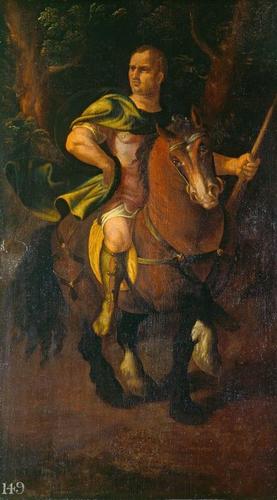-
1 of 253523 objects
The Emperor Otto on Horseback c. 1536-9
Oil on panel | 86.9 x 49.5 cm (support, canvas/panel/stretcher external) | RCIN 404729

Workshop of Giulio Romano (Rome c. 1499-Mantua 1546)
The Emperor Otto on Horseback c. 1536-9
-
This is one of five panels in the Royal Collection by Giulio Romano that originally belonged an elaborate decorative scheme for the state apartments within the Palazzo Ducale, Mantua. This panel comes from one of the grandest rooms, the Camerino dei Cesari (Cabinet of the Caesars), the decoration of which consisted principally of eleven powerful canvases of the Roman Emperors by Titian. The subject matter is drawn from Suetonius’s Lives of the Caesars, and reflects Federico Gonzaga’s obsession with imperial themes. Completed in 1540, Titian’s images were sadly destroyed by fire in Spain in 1734.
Giuilo played a subsidiary role in the decoration of the room; responsible for the broader ensemble into which Titian’s ‘portraits’ were fitted, he provided scenes from the life of each Emperor, to be placed below the portraits (of the original eleven only four have survived, three are in the Royal Collection). Flanking these scenes were mounted figures by Giulio representing the Emperors, and one female figure with a horse representing Victory (there were probably originally twelve of these figures, of which nine survive, two are in the Royal Collection). The ensemble of three walls (omitting the west wall) is recorded by drawings attributed to Ippolito Andreasi, c.1568 (Museum Kunst Palast, Düsseldorf), commissioned by the antiquarian Jacopo Strada. The relationship between the grand Titian figures and Giulio’s narrative scenes below has been compared to the hierarchy of an altarpiece: the predella with anecdotal scenes from the life of the saint who is depicted above, standing in majesty. Giulio’s skill lay in the illusionistic ensemble, bringing together architecture, painting and sculpture, designed to complement Titian’s work.
An Emperor on Horseback comes from the set of panels which framed the scenes from the lives of the emperors. It is likely that they represent the emperors, rather than Roman soldiers or attendants. Early sources and inventories identify them as emperors or ‘Caesars’. Andreasi’s drawn copies show that many of the figures had symbols of rule or triumph, such as batons or laurel wreaths. He also recorded commemorative plaques, probably originally in stucco, above and below each figure on horseback, many of which name emperors themselves. There were probably twelve in number, but the lack of an Andreasi drawing for the west wall makes this difficult to establish.Provenance
Gabinetto dei Cesari, Palazzo Ducale, Mantua; 1627 Mantuan inventory; acquired by Charles I; recorded by Abraham van der Doort in 1639 in the Gallery, St James's Palace; sold from St James's as a set of 11 for £100 to Ralph Grynder and others on 23 October 1651 (no 220); recovered at the Restoration and listed in the King's Privy Gallery at Whitehall in 1666 (no 150)
-
Creator(s)
Acquirer(s)
-
Medium and techniques
Oil on panel
Measurements
86.9 x 49.5 cm (support, canvas/panel/stretcher external)
95.2 x 58.6 x 4.5 cm (frame, external)
Category
Object type(s)
Other number(s)
Alternative title(s)
A Roman Soldier on Horseback
A Roman Emperor on horseback, previously identified as